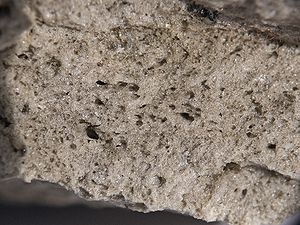Pumice

Specimen of highly porous pumice from Teide volcano on Tenerife, Canary Islands. Density of specimen approx 0.25 g/cm³. Scale is in centimeters.
Pumice is a term for a lightweight volcanic rock.
It is a solidified frothy lava, created when highly-heated, pressured molten rock is shot out from a volcano. Its light weight is due to air spaces, which are caused by fast cooling and loss of pressure. The loss of pressure makes bubbles by lowering the boiling point of the lava (like the bubble-creation when a carbonated drink is opened). The cooling then freezes the bubbles in the matrix.
Uses
Most famously, pumice stone has been used as a skin-scraper. It is used in pedicure to remove excess skin from the bottom of the foot, and on calluses (tough areas of skin).
It has also been used to make lightweight blocks for building, and as a powdered ingredient in polishing.
